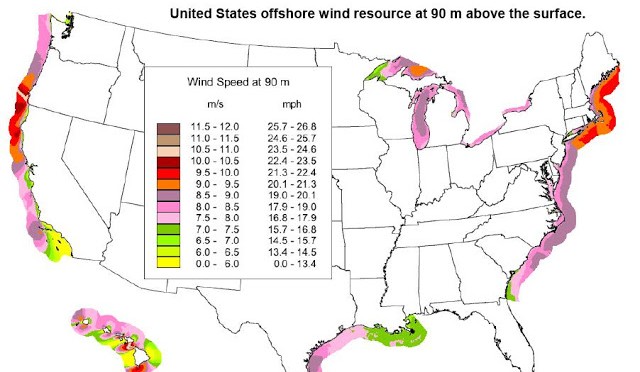The most recent U.S. Census states that 44.4 million people, or nearly 14% of the population, live along the Atlantic Coast. That is a lot of people—who need a lot of electricity. And as the country pushes to decarbonize the energy sector, that power needs to increasingly come from renewable sources, like solar and wind.
But densely populated coastlines often do not have the space needed for large solar or wind farms. That is why developers and scientists are looking to offshore wind energy to play a key role in supporting a low-carbon future for East Coast communities. And that is also why researchers at the National Renewable Energy Laboratory (NREL) and the Pacific Northwest National Laboratory (PNNL) have spent two years evaluating transmission options to make the best possible connections between offshore wind projects and communities on the Atlantic Coast.
The Atlantic Offshore Wind Transmission Study was the most thorough analysis to date of options for bringing offshore wind energy onshore to communities on the Atlantic Coast.

The goal of the study was to identify ways to facilitate transmission of offshore wind energy to areas of high demand and reduce grid congestion, increase system reliability, maximize production, and reduce costs for consumers.
The study also informed the concurrently released Atlantic Offshore Wind Transmission Action Plan, which outlines immediate actions the United States needs to do to connect the first generation of Atlantic offshore wind power projects to the electric grid and how they can increase transmission in the next several decades.
The Benefits of Interconnection
Study authors outlined one significant step that would help lower electricity costs and enhance U.S. grid reliability—while reducing disruption to ecosystems or other ocean users. The step? Linking offshore wind energy projects to each other first rather than connecting them individually to the grid back on land.
“We found that the benefits of connecting offshore wind energy stations outweigh the costs of installing those individual connections by a ratio of 2:1 or more,” said Greg Brinkman, an NREL senior research engineer and co-author of the report along with Dave Corbus, an NREL power systems engineer, and colleagues from PNNL. “Creating these transmission networks would yield substantial savings when compared to a scenario in which each project has its own isolated transmission connections.”
To then get energy from those networks of offshore wind farms back to land, the team identified potential transmission “corridors”—sites that avoid location constraints such as military zones and shipping channels, as well as marine protected areas and artificial reefs.
The study, which was based on a target of deploying 85 gigawatts of offshore wind off the Atlantic Coast by 2050, found that building offshore transmission in phases could help reduce risks. Study authors also suggested that the nation implement standards for high-voltage direct current technology early in the process to help developers lay new transmission lines and expand those networks in the future.
The Atlantic Offshore Wind Transmission Study was funded by the U.S. Department of Energy’s Wind Energy Technologies Office. The Atlantic Offshore Wind Transmission Action Plan was led by the U.S. Department of Energy’s Grid Deployment Office in partnership with the Wind Energy Technologies Office and the U.S. Department of Interior’s Bureau of Ocean Management.
Learn more about the Atlantic Offshore Wind Transmission Study and subscribe to NREL’s Leading Edge newsletter for more wind energy news.

